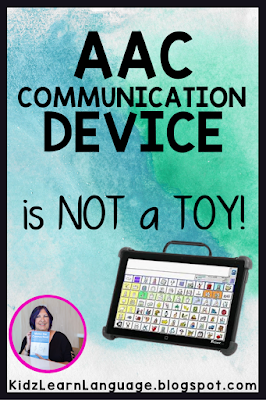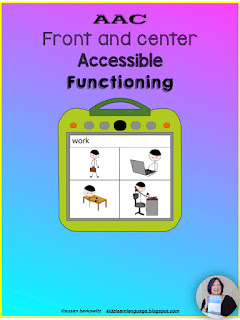This blog post is going o begin with one of those, “If I had a nickel for every time I heard….” lines. Over and over parents and professionals alike express their fears that the child will use the voice output AAC system like a toy; either banging repetitively on a single message or bouncing from page to page hitting random buttons.
It is the excuse heard most often after, “He isn’t smart enough.” (Never, of course put quite so bluntly.) “He just plays with it,” - or some version of that - is tossed around by people who have clearly not learned how to teach a child to communicate. I say this with no disrespect; just a desire to have people be honest with me and with parents.
Yes, kids will often activate the same button repeatedly. When a toddler says the same (usually new) words over and over again parents may despair, but none actually puts tape over the child’s mouth. That is exactly what is being done, however, when the device is taken away from a child because he is “just playing with it.”
Yes, when verbal kids are bored they can talk to themselves under their breath or whisper to their neighbor. And the teacher will admonish them. The AAC user who cannot adjust his own volume (or doesn’t recognize the need) can’t keep his boredom under wraps quite as easily.
And yes, there are undoubtedly kids who haven’t quite figured out the power of genuine communication yet, and just enjoy making verbal noise.
But teaching the child about the power of communication and how and when to use it; teaching the child how to use his AAC system, teaching the child about his ‘voice’ is our job. I am a big believer in the notion that if a student doesn’t use his AAC system appropriately for genuine communication then we haven’t been successful in teaching him. We haven’t done our job. And we need to do better.
Step 1. Make sure the device is appropriate for this particular child and make sure it is core word based and robust. A system lacking the vocabulary a child wants to use isn’t going to be valued.
Step 2. Make sure everyone who interacts with the child with any frequency is familiar with the system and able to use it. It’s hard to provide models when you can’t find the words.
Step 3. Make sure everyone is using Aided Language Stimulation - otherwise referred to as modeling. Nonverbal children learn language through modeling just like their verbal peers.
Step 4. Make sure the AAC system is always accessible. Kate Ahern’s motto: “See me, See my AAC” is paramount. The system should never be left in another room or on top of the filing cabinet.
Step 5. Make sure the environment and the people in it are all encouraging of genuine communication, are reinforcing the child’s communication attempts, and using appropriate strategies to encourage message production.
Playing with one’s voice should be a joyful thing. Don’t stifle that!
Keep on talking, and let your AAC users do likewise.
Looking for some materials to help staff know what to do with their AAC users? Try these:





It’s so important to teach everyone how to communicate with kids effectively. Without proper guidance, these systems can be underused or misunderstood. By focusing on the genuine use of these tools, we ensure that our teaching truly supports their communication development.
ReplyDelete